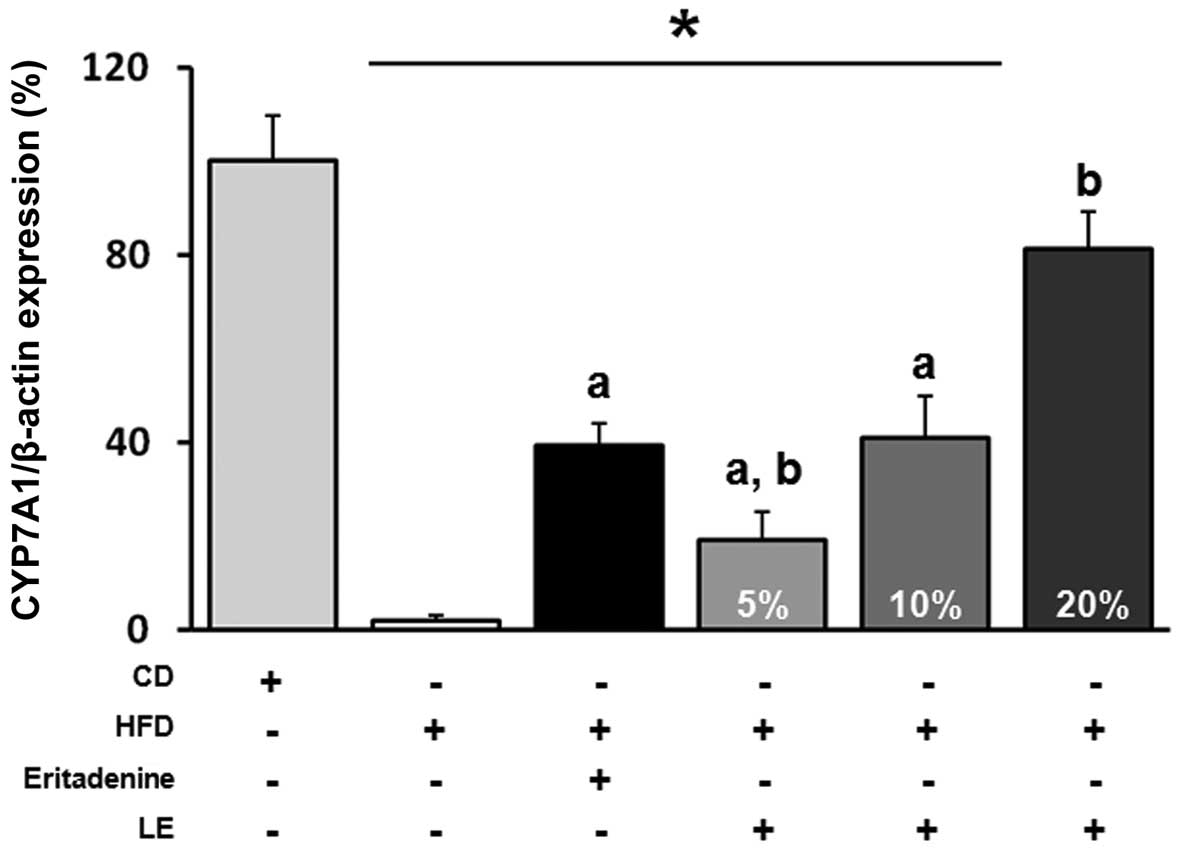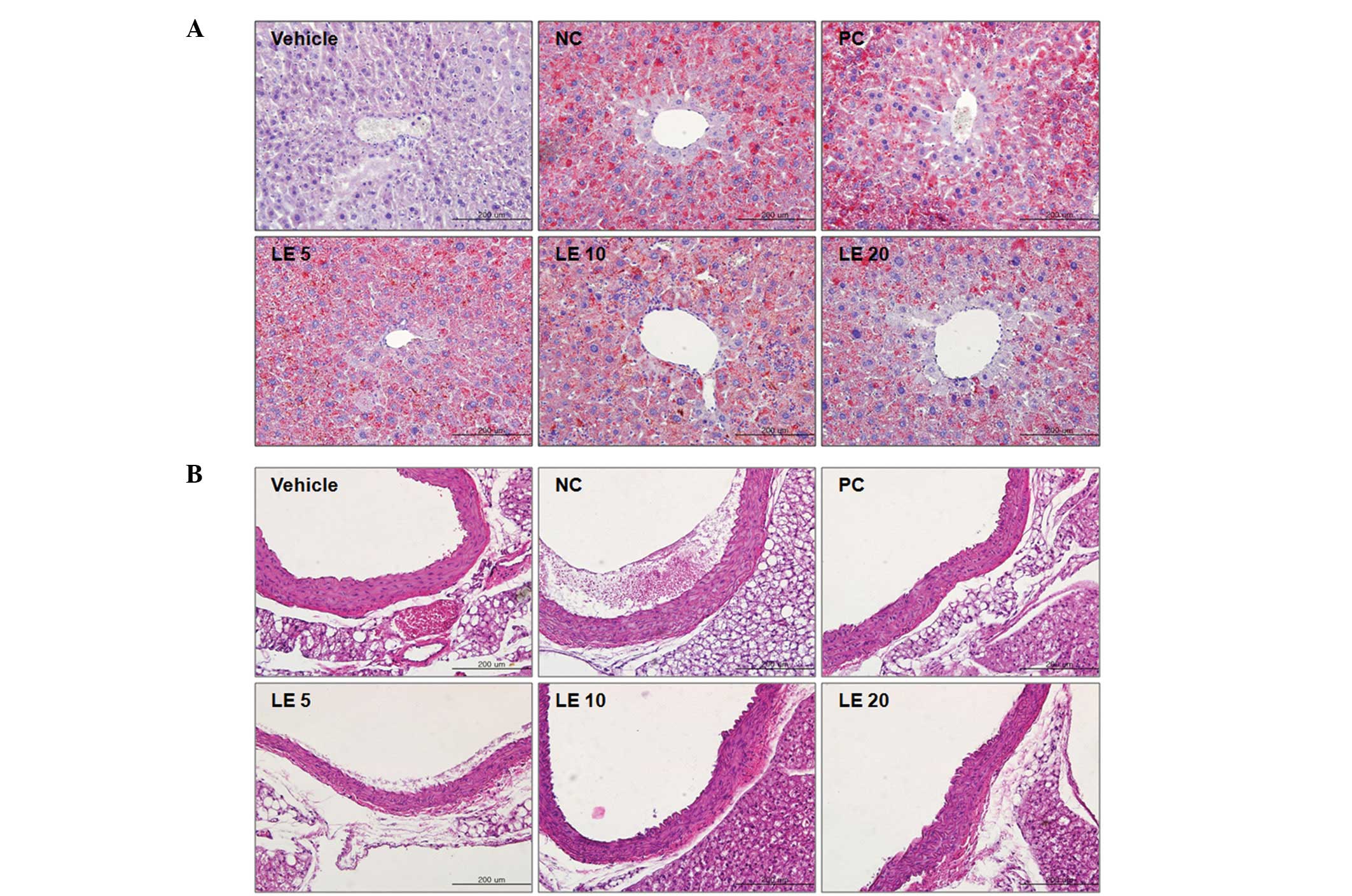|
1
|
Wasser SP: Shiitake (Lentinus
edodes). Encyclopedia of Dietary Supplements. View Article : Google Scholar : Marcel Dekker; New
York: pp. 653–664. 2005
|
|
2
|
Ngai PH and Ng TB: Lentin, a novel and
potent antifungal protein from shitake mushroom with inhibitory
effects on activity of human immunodeficiency virus-1 reverse
transcriptase and proliferation of leukemia cells. Life Sci.
73:3363–3374. 2003. View Article : Google Scholar
|
|
3
|
Shimada Y, Morita T and Sugiyama K:
Eritadenine-induced alterations of plasma lipoprotein lipid
concentrations and phosphatidylcholine molecular species profile in
rats fed cholesterol-free and cholesterol-enriched diets. Biosci
Biotechnol Biochem. 67:996–1006. 2003. View Article : Google Scholar
|
|
4
|
Sugiyama K, Akachi T and Yamakawa A:
Hypocholesterolemic action of eritadenine is mediated by a
modification of hepatic phospholipid metabolism in rats. J Nutr.
125:2134–2144. 1995.PubMed/NCBI
|
|
5
|
Shimada Y, Morita T and Sugiyama K:
Dietary eritadenine and ethanolamine depress fatty acid desaturase
activities by increasing liver microsomal phosphatidylethanolamine
in rats. J Nutr. 133:758–765. 2003.PubMed/NCBI
|
|
6
|
Fukada S, Setoue M, Morita T and Sugiyama
K: Dietary eritadenine suppresses guanidinoacetic acid-induced
hyperhomocysteinemia in rats. J Nutr. 136:2797–2802.
2006.PubMed/NCBI
|
|
7
|
Adachi R, Honma Y, Masuno H, et al:
Selective activation of vitamin D receptor by lithocholic acid
acetate, a bile acid derivative. J Lipid Res. 46:46–57. 2005.
View Article : Google Scholar : PubMed/NCBI
|
|
8
|
Teo NH, Scott JM, Reed B, Neale G and Weir
DG: Bile acid inhibition of vitamin B12 binding by intrinsic factor
in vitro. Gut. 22:270–276. 1981. View Article : Google Scholar : PubMed/NCBI
|
|
9
|
Seo YK, Chung YT, Kim S, Echchgadda I,
Song CS and Chatterjee B: Xenobiotic- and vitamin D-responsive
induction of the steroid/bile acid-sulfotransferase Sult2A1 in
young and old mice: the role of a gene enhancer in the liver
chromatin. Gene. 386:218–223. 2007. View Article : Google Scholar : PubMed/NCBI
|
|
10
|
Russell DW and Setchell KD: Bile acid
biosynthesis. Biochemistry. 31:4737–4749. 1992. View Article : Google Scholar
|
|
11
|
Hubacek JA and Bobkova D: Role of
cholesterol 7alpha-hydroxylase (CYP7A1) in nutrigenetics and
pharmacogenetics of cholesterol lowering. Mol Diagn Ther.
10:93–100. 2006. View Article : Google Scholar : PubMed/NCBI
|
|
12
|
Moon MS, Lee MS, Kim CT and Kim Y: Dietary
chitosan enhances hepatic CYP7A1 activity and reduces plasma and
liver cholesterol concentrations in diet-induced
hypercholesterolemia in rats. Nutr Res Pract. 1:175–179. 2007.
View Article : Google Scholar : PubMed/NCBI
|
|
13
|
Chawla A, Saez E and Evans RM: Don’t know
much bile-ology. Cell. 103:1–4. 2000.
|
|
14
|
Liu Y, Wu H, Wu W, Li R and Huang Y:
Intervention of Huanglian Jiedu decoction on haemorheology and
cholesterol-supplemented diet. Zhongguo Zhong Yao Za Zhi.
34:600–604. 2009.(In Chinese).
|
|
15
|
Tuncer MA, Yaymaci B, Sati L, et al:
Influence of Tribulus terrestris extract on lipid profile
and endothelial structure in developing atherosclerotic lesions in
the aorta of rabbits on a high-cholesterol diet. Acta Histochem.
111:488–500. 2009.
|
|
16
|
von Holt K, Lebrun S, Stinn W, Conroy L,
Wallerath T and Schleef R: Progression of atherosclerosis in the
Apo E−/− model: 12-month exposure to cigarette mainstream smoke
combined with high-cholesterol/fat diet. Atherosclerosis.
205:135–143. 2009.
|
|
17
|
Chibata I, Okumura K, Takeyama S and
Kotera K: Lentinacin: a new hypocholesterolemic substance in
Lentinus edodes. Experientia. 25:1237–1238. 1969. View Article : Google Scholar : PubMed/NCBI
|
|
18
|
Kabir Y, Yamaguchi M and Kimura S: Effect
of shiitake (Lentinus edodes) and maitake (Grifola
frondosa) mushrooms on blood pressure and plasma lipids of
spontaneously hypertensive rats. J Nutr Sci Vitaminol (Tokyo).
33:341–346. 1987.
|
|
19
|
Carbonero ER, Gracher AHP, Komura DL, et
al: Lentinus edodes heterogalactan: Antinociceptive and
anti-inflammatory effects. Food Chem. 111:531–537. 2008. View Article : Google Scholar
|
|
20
|
Lee GS, Byun HS, Yoon KH, Lee JS, Choi KC
and Jeung EB: Dietary calcium and vitamin D2 supplementation with
enhanced Lentinula edodes improves osteoporosis-like
symptoms and induces duodenal and renal active calcium transport
gene expression in mice. Eur J Nutr. 48:75–83. 2009.PubMed/NCBI
|
|
21
|
Takashima K, Sato C, Sasaki Y, Morita T
and Takeyama S: Effect of eritadenine on cholesterol metabolism in
the rat. Biochem Pharmacol. 23:433–438. 1974. View Article : Google Scholar : PubMed/NCBI
|
|
22
|
Enman J, Rova U and Berglund KA:
Quantification of the bioactive compound eritadenine in selected
strains of shiitake mushroom (Lentinus edodes). J Agric Food
Chem. 55:1177–1180. 2007. View Article : Google Scholar : PubMed/NCBI
|
|
23
|
Peet DJ, Turley SD, Ma W, et al:
Cholesterol and bile acid metabolism are impaired in mice lacking
the nuclear oxysterol receptor LXR alpha. Cell. 93:693–704. 1998.
View Article : Google Scholar : PubMed/NCBI
|
|
24
|
Torchia EC, Cheema SK and Agellon LB:
Coordinate regulation of bile acid biosynthetic and recovery
pathways. Biochem Biophys Res Commun. 225:128–133. 1996. View Article : Google Scholar : PubMed/NCBI
|
|
25
|
Agellon LB, Drover VA, Cheema SK, Gbaguidi
GF and Walsh A: Dietary cholesterol fails to stimulate the human
cholesterol 7alpha-hydroxylase gene (CYP7A1) in transgenic mice. J
Biol Chem. 277:20131–20134. 2002. View Article : Google Scholar : PubMed/NCBI
|
|
26
|
Lambrinoudaki I, Kaparos G, Papadimitriou
D, et al: Methylenetetrahydrofolate reductase C677T polymorphism is
associated with central adiposity and increased androgenicity in
healthy postmenopausal women. Eur J Endocrinol. 159:233–241. 2008.
View Article : Google Scholar
|
|
27
|
Hofman MK, Princen HM, Zwinderman AH and
Jukema JW: Genetic variation in the rate-limiting enzyme in
cholesterol catabolism (cholesterol 7alpha-hydroxylase) influences
the progression of atherosclerosis and risk of new clinical events.
Clin Sci (Lond). 108:539–545. 2005. View Article : Google Scholar
|
|
28
|
Yiu WF, Kwan PL, Wong CY, et al:
Attenuation of fatty liver and prevention of hypercholesterolemia
by extract of Curcuma longa through regulating the expression of
CYP7A1, LDL-receptor, HO-1, and HMG-CoA reductase. J Food Sci.
76:H80–H89. 2011. View Article : Google Scholar : PubMed/NCBI
|
















